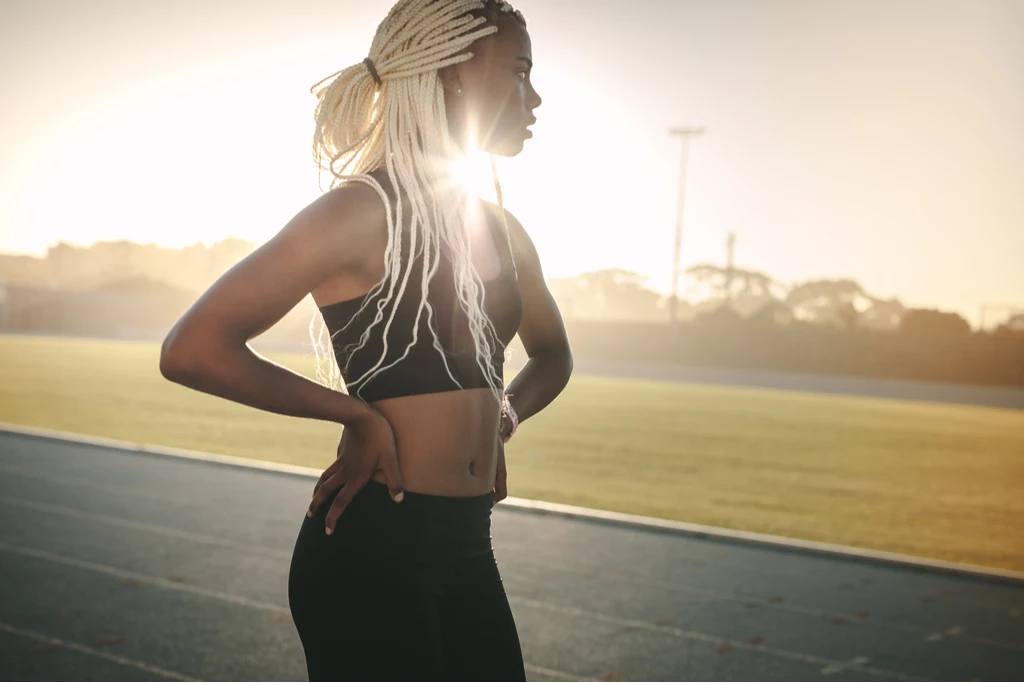How To Get Rid Of Side Stitch

August 9, 2021

If you’ve ever been in the middle of a workout or cardio session and felt a sharp, stabbing pain just below your ribs, you’ll know how painful – and debilitating – a side stitch can be. Getting through a workout can be hard enough without adding a side stitch to the mix!
So what is a side stitch? And how can you get rid of it or avoid it in the first place?
What is a side stitch?
According to Cleveland Clinic, a side stitch, also known as exercise-related transient abdominal pain (ETAP), is a cramp or spasm of your diaphragm – the large muscle that separates your chest from your abdomen.
A side stitch can feel like a painful cramping sensation, a stabbing pain, or a dull ache. For some people, it only lasts a few minutes or stops as soon as they take a break, while for others a side stitch hangs around for the entire exercise session and may even linger afterwards.
It is especially common in activities that involve repetitive torso movement, such as running, swimming and horse riding.
What can trigger a stitch?
According to a 2006 report published in the American College of Sports Medicine, the exact cause is still inconclusive, however research suggests there could be a few explanations for a side stitch.
As Cleveland Clinic points out, there are theories around increased blood flow to your liver and spleen, an imbalance of electrolytes in the blood, dehydration (or too much water!), what and when you’ve eaten, or movements of your internal organs and diaphragm.
A 2015 study on ETAP (the technical acronym for side stitch) also pointed out another possible explanation - irritiation of your abdominal lining.
Researchers suggest the irritation may be a result of increased friction, exercising too soon after a meal or a decrease in the lubricating fluid during exercise.
Should you keep exercising with a side stitch?
If you feel a side stitch coming on while exercising, the good news is you don’t have to stop moving or need to panic, as stitches are harmless (albeit painful). Luckily, there are also ways to ease the pain or stop the cramps from getting worse so you can keep moving.

How to get rid of side stitch
Here are a few ways you can prevent or treat the dreaded side stitch.
Slow down
If you get a side stitch during any type of cardio such as running, swimming or hiking, slow down and wait until the pain subsides before picking up your speed again. If you find slowing down doesn’t make a difference, try taking a short break.
Take deep breaths or change your breathing pattern
Once you’ve slowed down, focus on taking deeper, slower breaths that come from your belly rather than your chest. One research article also suggests changing your breath and stride patterns. If you get a stitch on your left side, exhale as your right foot hits the ground and do the opposite if you get a stitch on your right side.
Bend or stretch it out
Stretch your abdominal muscles by reaching one hand overhead and bend gently towards the side you feel the stitch. You might also find that bending forward as you breathe deeply helps to ease the pain.
Don't exercise too soon after eating
Always wait at least 90-120 minutes after eating before exercising. Your digestive system may become irritated or uncomfortable if you work out too soon, as your blood flow is directed away from your stomach and towards your muscles.
Sip water during exercise
Dehydration can cause a stitch – and so can drinking too much — so take small sips of water before and during your workout.
Massage the area
In some cases it can help to gently press your fingers into the area where you feel pain and massage or hold your fingers there as you take a few deep breaths.
Strengthen your core
A 2014 study of 50 runners published in The Journal of Science and Medicine in Sport found that having a stronger core could reduce how often you get a stitch.
When you run, jump or skip, your internal organs move up and down which pulls on your diaphragm muscles. Strengthening and engaging your core can help strengthen weak diaphragm muscles, making them more resilient to fatigue and less likely to cramp.
Improve your posture
Studies have suggested people with poor postural alignment are more predisposed to stitches. Simple core, glute and back exercises can help improve your posture and correct a slouching posture – try bridges, back extensions and planks.
Try not to perform movements with hunched posture during your workouts and stand tall and keep a proud chest and shoulders where possible. This applies to running and walking, too!
Work on your cardio fitness
If it’s cardio workouts that tend to bring on a side stitch, it’s common to find they subside or occur less frequently as your fitness builds. Keep at it!
Incorporate dynamic stretching in your warm-up
Setting aside 5-10 minutes for a warm-up is essential, and adding some dynamic stretches to your pre-workout routine could make a difference. Focus on twisting, reaching and arching your torso to stretch the muscles around your core, ribs and sides.
Manage side stitches and get back on track with your workouts
You’ll be hard-pressed to find someone who hasn’t experienced a side stitch at some point during their life, so don’t worry – it’s very common and nothing to worry about.
A side stitch should go away within a few minutes after you slow down, stretch or stop exercising. If you find you’re getting them all the time, try to leave more time between eating and exercising, eat a lighter pre-workout snack, and avoid working out dehydrated or with a belly full of water.
Other tactics include practising good posture, decreasing the length of your workout if necessary, or gradually increasing the duration or intensity of your workouts over time.
If you’re experiencing pain in your side or abdomen that’s different from your usual side stitch sensation or it’s accompanied by symptoms like swelling or a fever, get in touch with your healthcare provider immediately.

A more empowered you starts with Sweat, and our editorial team is here to bring you the latest fitness tips, trainer recommendations, wellbeing news, nutritional advice, nourishing recipes and free workouts.
* Disclaimer: This blog post is not intended to replace the advice of a medical professional. The above information should not be used to diagnose, treat, or prevent any disease or medical condition. Please consult your doctor before making any changes to your diet, sleep methods, daily activity, or fitness routine. Sweat assumes no responsibility for any personal injury or damage sustained by any recommendations, opinions, or advice given in this article.
Fitness